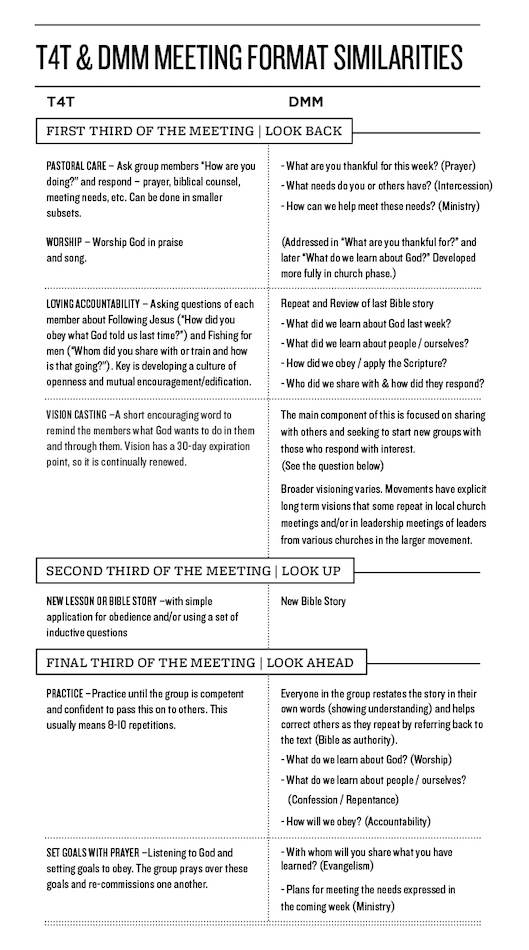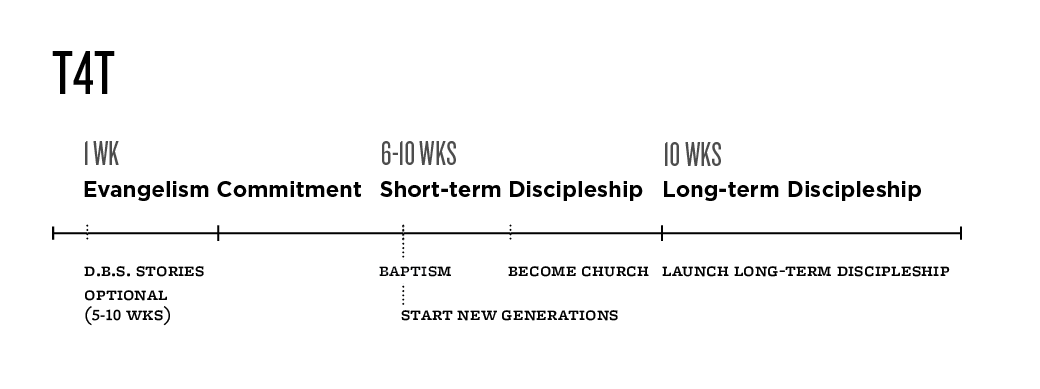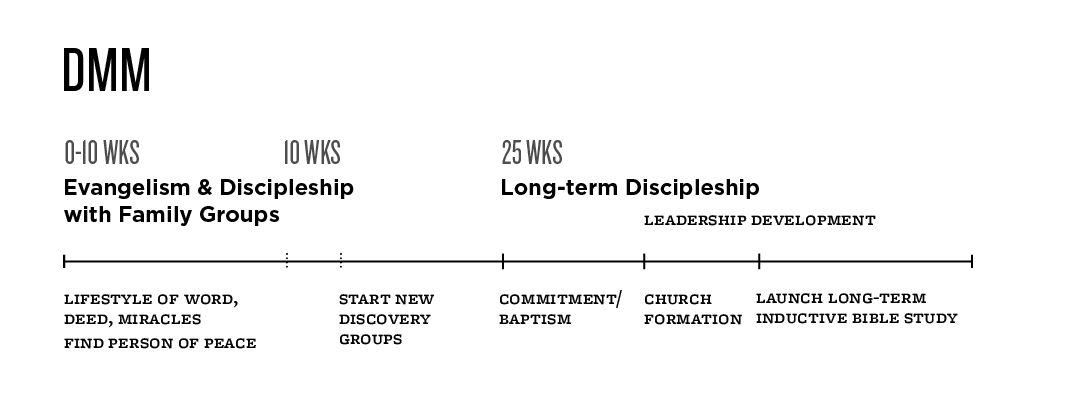T4T or DMM (DBS)? Only God can start a Church Planting Movement! - Part 2 of 2
Kingdom Kernels

In the January-February 2015 issue, we examined how two common Church-Planting Movement (CPM) approaches compare to each other. One is Training for Trainers (T4T) and the other is Disciple-Making Movements (DMM). Part Two examines the mechanics of T4T and DMM and how many CPM practitioners are blending elements of each.
Similarities and Differences in T4T & DMM Meetings
Some nuances of each approach can be understood by comparing the typical format of these small group Bible studies that become the new church meetings. T4T meetings stress the three-thirds (3/3) process to develop and train trainers. Meetings are divided into roughly three parts – 1) look back, 2) look up and 3) look ahead. Within these three parts are seven elements – elements that primarily give life to the group members (Pastoral Care, Worship, Bible Study) and elements that help them give life to others (reproduction – Accountability, Vision-Casting, Practice, and Setting Goals with Prayer). These latter elements are called the bold parts because they are essential to reproduction.
DMM meetings use questions so the group can discover what the Holy Spirit is teaching, obey it and pass it on. DMM meetings cover similar dynamics as 3/3 but there are different nuances. Questions can and do vary, but the following is a typical set of questions.
A Comparison of the Typical Progression of T4T and DMM over Several Months
In addition to the differences in how meetings occur, the general progression of the two models through the stages of entry (finding people), evangelism and commitment, discipleship (short and long term), church formation, leadership development, on-going development and starting new generations varies. Both arrive at a similar point several months into the process but the approach to get there is different.
ENTRY – Finding God-Prepared People:
· T4T: Practitioners mobilize as many believers as possible to evangelize. Each member shares the gospel frequently, especially with their oikos at least 5x a week, using a name list (or oikos map) of the oikos. They may share with individuals or small group of gathered friends. Members also share with strangers looking for persons of peace.
· DMM: Believers are trained and equipped to share the gospel in word, deed, miracles, and lifestyle to find persons of peace (Luke 10) who will open their household/oikos (circle of strong influence) to discovering God through Bible study.
Evangelism & Commitment
· T4T: Normally T4T uses one contextualized gospel presentation with a call to commitment. The evangelist wins the individual or household and helps them then share the gospel with others. With those that are open but not ready to believe, sometimes the evangelist shares 5-10 more stories. Decisions are often with individuals, and sometimes with groups. Miracles often open doors. Larger groups are usually reached via equipping the new believer to share with his oikos.
Discipleship
· T4T: After the person (and his oikos sometimes) believe, they enter a discipleship phase of both 6-10 short term lessons/Bible studies (oral or literate) with clear application points. At the end of this time the group moves into a long-term discipleship approach using inductive Bible studies with regular questions that help explain and apply the Scripture. Baptism is usually the first or second short-term discipleship lesson.
Evangelism & Discipleship
· DMM: Evangelism and discipleship is combined in a 10-26 week discovery Bible story process helping the oikos know and obey God and share with others. The whole oikos is called to commitment at the end of this cycle. Sometimes the oikos is ready for commitment before the end, especially when miracles occur. In this case, after commitment/baptism they would continue the cycle since the goal is worldview change and reproducibility. Decisions are generally group decisions. Miracles often open doors.
Commitment
· Many DMMs have a set Bible study (1-4 sessions) as the persons/oikos is examining the decision to commit to Christ as Lord. This allows them to biblically discover the commitment rather than getting it from the outsider. Typical biblical topics covered are repentance, renunciation, Lordship, persecution, Baptism. Baptism occurs when the commitment is made.
New Generation
· T4T: As soon as a person/group believes, they are taught to share the gospel with their oikos and start their own next generation groups with them while they themselves are being discipled in the current T4T group. Group members sometimes start multiple groups in the succeeding weeks.
· DMM: Discovery groups share stories with others each week. When someone shows interest, a new group is formed with that oikos (facilitated by the outside disciple). We know of two different situations where a discovery group during a 26-week cycle helped start 20+ new discovery groups.
Church Formation
· T4T: The T4T group usually becomes a church (i.e. practicing the basic functions and identity of church) within the short-term discipleship phase, usually at week four or five after salvation.
· DMM: After baptism begin discovery Bible training on “being a disciple” (such as “life of Jesus” or “commands of Christ”) and “being a church” (such as church metaphors, functions, nature, structure).
Leadership Development
· T4T: Leadership development begins immediately as all group members are trained to repeat the process with others to see which leaders emerge; coaching happens in the three-thirds process. Fruitful leaders are brought together regularly for mid-level training. Emerging gifted and faithful leaders are personally mentored to begin overseeing streams of churches.
· DMM: All disciples are given leadership opportunities and many of them help start new groups and develop new leaders. Leadership discovery lessons (such as 20 Matthew leadership studies) are open to all. Ongoing broader leadership trainings and coaching and mentoring are offered for leaders throughout the movement.
On-Going Development
· T4T & DMM: For long-term development (discipleship) of church members in addition to the leadership development above, inductive Bible study of the whole counsel of God’s Word is the pattern using questions to unlock the meaning and application of the text. This enables churches to obey all of the Word and for various gifts to emerge.
How The Two Models areGetting Blended
Even within T4T and DMM there are a wide variety of adaptations and customizations. CPM practitioners constantly learn and borrow elements from each other, which results in somewhat blended models. Elements are typically borrowed to address certain issues. For example:
· Many T4T practitioners have added a “yellow light” phase to their evangelism. If listeners believe after hearing the gospel (green light) they move into discipleship. If they refuse (red light) the evangelist moves on. But if they are “open” to hearing more (yellow light), then T4T practitioners often use 5-10 short discovery Bible studies (based on their worldview), usually with their oikos, to help them understand more and wait on God to answer prayer requests. If T4T practitioners determine this is the normal response of people, they may move directly to using 5-10 DBS stories from the beginning as their evangelism method.
· Some DMM practitioners will use a worldview appropriate gospel presentation as a way to filter while in the stage of looking for persons of peace.
· Many T4T practitioners are taking time to not only witness to individuals but to purposefully try to find houses of peace and then share the gospel with the whole house of peace.
· Many DMM practitioners are willing to fast-forward to commitment to Christ when miracles create readiness in an oikos. These practitioners are encouraged to finish the series after baptism so that the new church will know how to make disciples.
· Some T4T practitioners, often in oral environments, are using discovery Bible stories for their short-term discipleship phase, though they will direct the process toward a standard application.
· Some DMM practitioners have adapted emphases from the three-thirds process, especially the vision-casting and prayer goals.
· Many T4T practitioners, especially in environments where church members are afraid of sharing the gospel, are doing House of Peace searches (usually over a weekend) two by two and then starting a process of 3-7 DBS stories with them leading up to a gospel presentation. This process is fast-forwarding the reticence church members have in witnessing to their oikos or when their oikos has all heard the gospel.
What these practitioners are learning is that the method is not sacred. They are striving to cooperate with the Holy Spirit to see Church-Planting Movements launched.[1] They are using methods that they feel return them to biblical principles and bear the best fruit in their context.
In hostile environments practitioners from both models have often found it helpful to start discovery studies with groups of people. In fractured oikos environments, many practitioners are using the T4T model of working with individuals who can then be trained to share in their relational networks, since oikos communities are hard to find. In contexts in which decisions are made communally, practitioners are emphasizing getting into a house of peace and winning a whole group whether through one gospel presentation or multiple studies.
Both models, and their blended versions, have borne the fruit of many CPMs on every major continent and in every major worldview. Which you use, and which blends you develop, will depend on some of your theological convictions, the modeling and training you receive and the needs of your context.
Both models have much more in common than what is different. Both have proven themselves to be effective at helping disciples make disciples who make disciples who make disciples, and forming these into churches. For both models the benchmark of a movement is the same as Paul’s in Romans 15:23: no place left where Christ is not being named.
[1] One caution: “DMM” is being used by some people to describe a disciple-making process that puts less emphasis on church formation. Discipleship groups are started but churches often are not. This is not DMM! “DMM” as described in this article is a method to get to church-planting movements.












comments